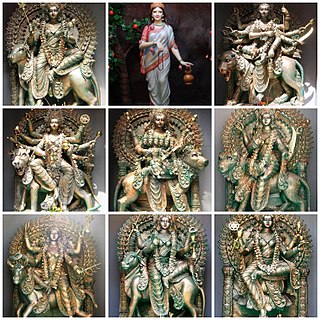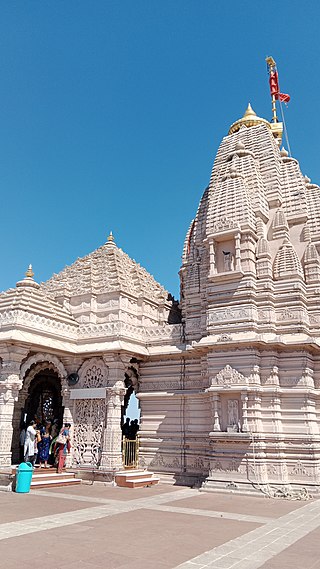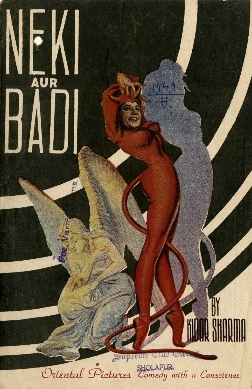Related Research Articles
Phul Mata is a Hindu goddess of disease, one of a group of seven sister goddesses with similar associations. Her sisters were Sitala Mata, Chamariya mata, Durga Kali, Maha Kali, Bhadra kali and Kalika Bhavani. As a group, they were well known in northern India, and were often represented by balls of clay. Phul Mata was specifically associated with typhoid fever.

Navadurga, also spelled Navdurga and Navadurgas, are nine manifestations and forms of Durga in Hinduism, especially worshipped during Navaratri and Durga Puja. They are often considered collectively as a single deity, mainly among the followers of Shaktism and Shaivism sect of Hinduism.

The Meghwal or Meghwar people live primarily in northwest India, with a small population in Pakistan. Their traditional occupation was agricultural farming, cattle-herding and weaving. Meghwals are known for their contribution to embroidery and the textile industry. Most are Hindu by religion, with Rishi Megh, Kabir, Ram Devji and Bankar Mataji their chief gods.

Renuka, also known as Yellamma, is a Hindu goddess worshipped predominantly in the South Indian states of Karnataka, Tamil Nadu, Telangana, Kerala, Andhra Pradesh and western state of Maharashtra. She is also known as the mother of Parashurama, the sixth avatar of the god Vishnu. She acquired the status of a mother goddess before eventually being associated with the legend of Parashurama.

Santoshi Mata or Santoshi Maa is a Hindu goddess, who is venerated as "the Mother of Satisfaction", the meaning of her name. Santoshi Mata is particularly worshipped by women of North India and Nepal. A vrata called the Santoshi Maa vrata performed by women on 16 consecutive Fridays wins the goddess' favour.

Chamar is a Dalit community classified as a Scheduled Caste under modern India's system of affirmative action. They are found throughout the Indian subcontinent, mainly in the northern states of India and in Pakistan and Nepal.
Chuhra, also known as Bhanghi and Balmiki, is a Dalit caste in India and Pakistan. Populated regions include the Punjab region of India and Pakistan, as well as Uttar Pradesh in India, among other parts of the Indian subcontinent such as southern India. Their traditional occupation is sweeping, a "polluting" occupation that caused them to be considered untouchables in the caste system.

Sheetalalit. '"coolness"', also spelled as Shitala and Seetla, is a Hindu goddess venerated primarily in North India. She is regarded to be an incarnation of the goddess Parvati. She is believed to cure poxes, sores, ghouls, pustules, and diseases, and most directly linked with the disease smallpox. Sheetala is worshipped on Tuesday Saptami and Ashtami, especially after Holi during the month of Chaitra. The celebration of the goddess Sheetala on the seventh and eighth day of the Hindu month is referred to as the Sheetala Saptami and Sheetala Asthami, respectively.

Dwijendra Narayan Jha was an Indian historian who studied and wrote on ancient and medieval India. He was a professor of history at Delhi University and a member of the Indian Council of Historical Research. Some of his books include Ancient India: In Historical Outline (1997), The Myth of the Holy Cow (2001), and Early India: A Concise History (2004). Through his works he argued against the communal distortions of history including challenging popular beliefs of the sanctity of cow and Indian beef eating tradition.
Gurjar is an Indo-Aryan agricultural ethnic community, residing mainly in India, Pakistan and Afghanistan, divided internally into various clan groups. They were traditionally involved in agriculture, pastoral and nomadic activities and formed a large heterogeneous group. The historical role of Gurjars has been quite diverse in society: at one end they have been founders of several kingdoms and dynasties and, at the other end, some are still nomads with no land of their own.
Rajasthani people or Rajasthanis are a group of Indo-Aryan peoples native to Rajasthan, a state in Northern India. Their language, Rajasthani, is a part of the western group of Indo-Aryan languages.
Rajasthanis are predominantly Hindu, Muslims and Jains. However, regardless of their religious segments, Muslim, Hindu and Jain Rajasthanis mingle with each other socially. Most Rajasthani Hindus are vaishnavas, however, Durga and her avatars are equally worshiped throughout Rajasthan. Oswals are predominantly Jains but small section of vaishnava Oswals are also found.
Shetrunji River is an eastward-flowing river in Bhavnagar, Gujarat, in western India.
The Golla are a Telugu-speaking pastoral community primarily living in the states of Andhra Pradesh and Telangana with smaller numbers in Karnataka and Tamil Nadu. They are related to other pastoral-herding castes like Gulla, Gullar, Gollewar, Gavli and Dhangar and are a part of the larger Yadav community. They are classified as a Backward Caste.

Kālikā Mata Temple is a Hindu goddess temple complex and pilgrim centre at the summit of Pavagadh Hill in Panchmahal District, India, with in the Champaner-Pavagadh Archaeological Park. It dates from the 10th or 11th centuries. The temple has three images of goddesses: the central image is of Kalika Mata, flanked by Kali on the right and Bahucharamata on the left. On Chitra sud 8, a fair is held at the temple which is attended by thousands of devotees. The temple is the site of one of the Great holy Shakti Peethas. One can easily reach the temple by ropeway.

The Jammu division is a revenue and administrative division of the Indian-administered Jammu and Kashmir in the disputed Kashmir region. It is bordered by the Kashmir division to the north. It consists of the districts of Jammu, Doda, Kathua, Ramban, Reasi, Kishtwar, Poonch, Rajouri, Udhampur and Samba. Most of the land is hilly or mountainous, including the Pir Panjal Range which separates it from the Kashmir Valley and part of the Great Himalayas in the eastern districts of Doda and Kishtwar. Its principal river is the Chenab.

Seetla Mata is a folk deity forming part of Punjabi folk religion. Seetla is the goddess of smallpox and is worshiped for its recovery. She also manifests herself in the form of chicken pox and is venerated for recovery.

Panthoibi, also known as Nongpok Leima, is a goddess associated with civilization, courage, fertility, handicraft, love, victory, warfare and wisdom in the mythology and religion of Ancient Kangleipak. She is a consort of the God Nongpok Ningthou. She is considered to be one of the divine incarnations of Leimarel Sidabi and is also identified as a form of Goddess Nongthang Leima. She is worshipped mainly by the Meitei people in Manipur, Assam, Tripura, Bangladesh and Myanmar.

Vaishno Devi Temple, also referred to as Shri Mata Vaishno Devi Temple and Vaishno Devi Bhavan, is a Hindu temple dedicated to goddess Vaishno Devi, one of the major forms of the supreme goddess Lakshmi Devi. It is located in Katra, Reasi on the slopes of Trikuta Hills within the union territory of Jammu & Kashmir in India. Shakta traditions consider the temple as one of the 52 Maha (major) Shakti Peethas dedicated to Durga. The temple is governed by the Shri Mata Vaishno Devi Shrine Board (SMVDSB), chaired by the Government of Jammu and Kashmir in August 1986.

Neki Aur Badi is a 1949 Indian Hindi-language patriotic drama film directed by Kidar Sharma. The film stars Sharma with Madhubala and Geeta Bali. It was the only film in which Sharma played the male lead role.
References
- 1 2 Reddy, Prof Katta Narasimha; Reddy, Prof E. Siva Nagi; Naik, Prof K. Krishna (31 January 2023). Kalyana Mitra: Volume 10. Blue Rose Publishers.
- 1 2 Ferrari, Fabrizio M. (20 November 2014). Religion, Devotion and Medicine in North India: The Healing Power of Sitala. Bloomsbury Publishing. ISBN 978-1-4725-9872-1.
- 1 2 Zeitschrift für Ethnologie (in German). 1905.
- 1 2 Awadesh N. Sharma; Rajesh K. Gautam; Ajay K. Gharami (1 January 2006). Indigenous Health Care and Ethno-medicine. Sarup & Sons. pp. 251–253. ISBN 978-81-7625-724-4.
- 1 2 Georg Pfeffer; Deepak Kumar Behera (1997). Contemporary Society: Tribal situation in India. Concept Publishing Company. p. 281. ISBN 978-81-7022-984-1 . Retrieved 8 December 2014.
- ↑ Commissioner, India Census (1902). Census of India, 1901.
- ↑ Sanjay Sharma (25 April 2013). Baid, Hakim & Doctors: The Medicine Heritage of India. Leadstart Publishing Pvt Ltd. p. 72. ISBN 978-93-81576-48-9.